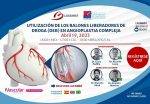TLR associated factors in patients with calcified nodules. Patients with complex cardiomyopathies undergoing percutaneous coronary intervention are increasingly common, as is the case for calcified lesions and calcified nodules (CN). Procedure complexity not only involves planning, but also establishing patient prognosis, taking into consideration the fact that most target vessel events occur at long term...
5 Year Evolution of PCI vs CABG in Large Randomized Studies on Acute and Chronic Coronary Syndrome
Left main lesions in acute coronary syndrome (ACS) represent a major risk and, at present, the best revascularization strategy is a matter of debate. Though many studies and registries have excluded this group of patients, there is data on the pros and cons of both percutaneous coronary intervention (PCI) and cardiac artery bypass graft (CABG). ...
Useful Predictor of Adverse Events in Complex PCI: BCIS CHIP Score
Among patients undergoing percutaneous coronary intervention (PCI), there is a need for risk stratification for successful planning and post procedural management. Risk stratification is paramount for effective decision making. For a long time, the SYNTAX score has been the preferred tool for complex PCI patient risk assessment. However, it has important limitations, such as inter-observer...
Is IVUS Useful in Lower Limb PCI?
Peripheral vascular disease is on the rise and peripheral PCI is at present the first choice of treatment for most patients. The use of IVUS in femoropopliteal territory has shown great benefits, especially in left main and complex PCI, reducing mortality and restenosis but, though promising, in lower limb ischemia we have little information as...
Post PCI Angina: Inevitable or Avoidable?
Predictors of post PCI angina Among the complications of ischemic cardiomyopathy stenting, those called chronic, with significant functional and mental compromise, might affect patient quality of life. This can be observed in different scenarios, such as instent restenosis and post PCI angina. This kind of complications is associated with anxiety and depression at long term. ...
ISAR Score: Can We Predict the Need for Repeat PCI in DES Restenosis?
Score to predict the risk of repeat PCI in DES restenosis. With the use of drug eluting stents (DES) instent restenosis (ISR) has seen a significant reduction vs. bare metal stents (BMS) restenosis. The main cause of DES failure is ISR. This entity is difficult to manage because of its high recurrence and reintervention risk....
AQCA Study: Pre-PCI Virtual QFR for Planning PCI vs. Conventional Angiography
Several studies have used physiological assessment after a percutaneous coronary intervention (PCI) to improve clinical outcomes. However, results are not entirely conclusive. The limitations of using these physiological assessment methods are the need for extra measurements with increased procedure time, more radiation, and more contrast, which in turn leads to higher costs. To counteract these...
04/19 – SOLACI-LATAM Bif Webinar | Use of Drug Coated Balloons in Complex PCI
On Wednesday, April 19th, at 7 pm (Argentinian/Brazil time) we will be holding a new open event together with LATAM Bif on the “Use of Drug Coated Balloons in Complex PCI”. The event will feature renowned Latin American speakers and panelists. April 19, 2023, 7:00 pm (Argentinian/Brazil time; UTC-3). Open and free of charge. Take...
ACC 2023 | RENOVATE-COMPLEX-PCI: Intravascular Imaging-Guided vs. Angiography-Guided Complex PCI
Patients with complex coronary artery disease (CAD) undergoing percutaneous coronary intervention (PCI) have worse clinical outcomes tan patients with non-complex CAD. Several studies have shown that the use of intravascular imaging (IVUS, OCT) have reduced major adverse events vs. angiography guided PCI. However, these studies present limitations both of size, studied population, short term followup...
Complex PCI with BioResorbable Scaffolds
Por Dr. Cristiano Guedes Bezerra.









